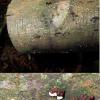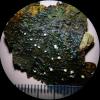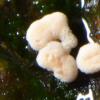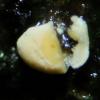
30-12-2025 16:44
Pascal DucosBonjour,Une anamorphe rose stipitée, très nombre

30-12-2025 17:14
 Bernard CLESSE
Bernard CLESSE
Bonjour à toutes et tous,Pourriez-vous aider Albe

29-12-2025 10:15
Hulda Caroline HolteHello, I found and collected this propoloid ascom

30-12-2025 09:04
Hello.A Pyrenomycete sprouting sparsely but very d

29-12-2025 17:44
Isabelle CharissouBonjour,J'aimerais savoir si d'autres personnes au

12-11-2021 00:03
Lepista ZacariasHi everybody,A week ago in my fiels trip I noticed

29-12-2025 17:12
 Bernard CLESSE
Bernard CLESSE
Bonjour à toutes et tous,Pourriez-vous m'aider à
Possible Geocladium luteolum
Steve Clements,
19-08-2014 16:18
Hi,
This was found on an old beech log, with Nectria coccinea. The pale off-white pulvinate (up to imm diameter) sporodochia? looked yellowish under LED and more pinkish under halogen light. Conidia were abundant and looked agglutinated, hyaline, up to 6 x 3 um. The only structures I could see were Penicillium-like phialides. Ellis and Ellis pointed to Geocladium luteolum as a possible ID. Does this make sense?
Steve
Paul Cannon,
19-08-2014 16:30
Re : Possible Geocladium luteolum
I think this is the anamorph of Nectria (now Neonectria) coccinea. It has a Cylindrocarpon anamorph which produces microconidia like your collection, as well as long curved Fusarium-like macroconidia.
Best wishes
Paul
Best wishes
Paul
Steve Clements,
19-08-2014 20:39
Re : Possible Geocladium luteolum
Thanks very much Paul, that makes sense, with its intimate relations with the N coccinea. It's another one for the list, all be it a conidial form!
Steve
Steve









